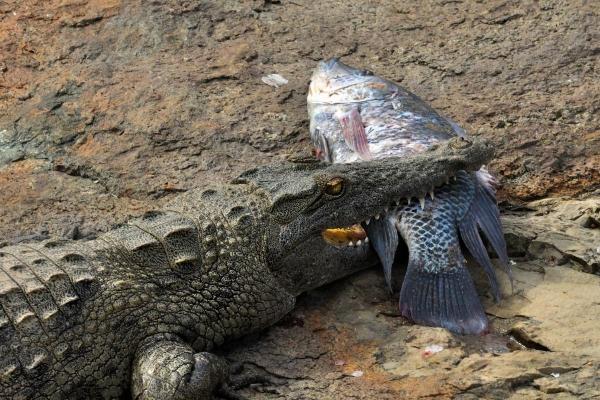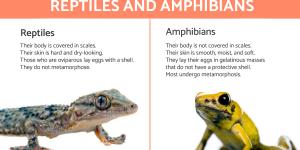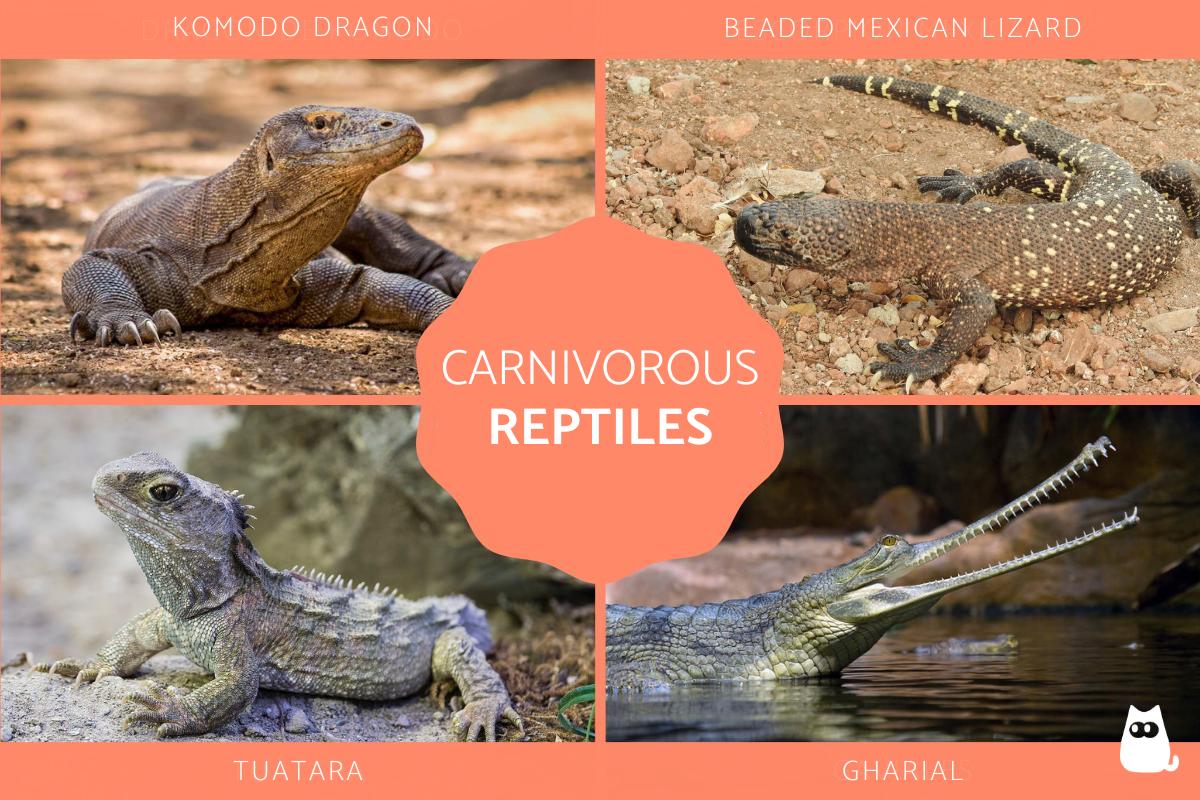Carnivorous Reptiles - Snakes, Lizards and More


Reptiles are a diverse group of vertebrates, with almost 12,000 individual species currently falling under this categorization. With such diversity, you may not be surprised to know reptiles differ in various ways, including physical characteristics, behaviors, habitat and diet. Many of these factors influence each other, especially when we consider long processes of evolutionary adaptation. What a reptile eats will depend largely on the food available in their habitat. Many reptiles are carnivores since they both require the nutrients found in animal meat, as well as the ability to successfully prey on other animals.
At AnimalWised, we discover more about these animals by looking at different types of carnivorous reptiles. These include snakes, lizards and other types of reptile.
Are all reptiles carnivorous?
Carnivorous reptiles are those which feed on other animals. To be considered a carnivore, an animal doesn't need to eat other animals exclusively. Instead, they need to constitute the main part of their diet and be unable to survive without it. When an animal eats other animals sometimes, but does not need them as part of their diet, they are considered omnivores.
Some reptiles are not considered carnivorous, even if they do eat some meat from other animals. Often this is due to scarcity in their habitat. They have adapted to eating fruit, insects or other food sources to survive. Some refer to reptiles which require insects as the main part of their diet as carnivores. However, they are more accurately described as insectivores.
There are very few truly herbivorous reptiles. Although there are some which will have fruit, vegetables and leafy greens as their main sources of food, many will also eat insects when available. Many different types of turtles fall into this category since they can be fed only vegetables and survive well.
This does not mean that all turtles are herbivores or omnivores. For example, the alligator snapping turtle (Macrochelys temminckii) is almost entirely carnivorous. They are adapted to this kind of diet thanks to their very sharp beak and pincer jaws. In contrast, all snake species are carnivorous, although they may supplement their diet with insects.
With this in mind, not all reptiles are carnivorous, but most are. Some are even apex predators in their environment, making them the most prominent carnivores in a given ecosystem. This is the case with alligators and crocodiles.
Characteristics of carnivorous reptiles
There are certain characteristics which all reptiles share. Although carnivores need to have certain traits which allow them to eat and metabolize other animals, they do not all do it in the same way. For this reason, we look at some of the features and characteristics of different types of carnivorous reptiles:
- Teeth: although many reptiles are carnivorous, they do not have the complex dental structure of mammals. This means they cannot chew their prey in the same way and often swallow them whole. The type of teeth will depend on the individual species. For example, crocodiles and alligators are polyphyodonts, meaning their can replace each individual tooth many times over the course of a lifetime.
- Jaws: they are endowed with wide, long muscles and a disposition that provides mechanical efficiency. Although they cannot chew food, they can crush and tear chunks with a lot of force. Although turtles do not have teeth, they have keratinized structures on their jaws which can act like a knife and kill smaller animals.
- Digestive system: starts at the mouth and ends in the cloaca. Generally speaking, reptiles will have a stomach, liver, pancreas, intestines and other digestive organs. The intestines are very important as the intestines of carnivorous animals are generally shorter, like those of carnivorous mammals. The digestive muscles are powerful, and the stomach possesses hydrochloric acid and digestive enzymes with a pH of 2-3.
- Digestion: this process is slow in carnivorous reptiles, especially large predators such as constrictor snakes or crocodiles. These animals will often consume large prey in one go and digest them over a long period of time. This means they will not need to feed again for a long time.
- Metabolism: as well as their digestion, the metabolism of carnivorous reptiles is slow. With few exceptions most reptiles are ectothermic, meaning they require external heat to increase their temperature.
- Venom: some of the most venomous animals in the world are reptiles. These include various snakes and lizards which have venom glands. They use these to inject venom into prey and paralyze them before killing and eating them, although not always in that order.
What do carnivorous reptiles eat?
The diet of carnivorous reptiles varies from one species to another. Some smaller species tend to be more generalized, meaning they can consume a greater diversity of prey. These are often supplemented with insects and spiders. Larger reptiles such a boa constrictors and crocodiles tend to not need these supplementary foods since they obtain sufficient nutrition from larger prey.
As indicated above, reptiles which consume only or a majority of insects in their diet are considered insectivores. However, we have included some of the list below to show the diversity of prey which carnivorous reptiles can consume:
- Birds
- Amphibians
- Fish
- Mollusks
- Crustaceans
- Jellyfish
- Deer
- Buffaloes
- Zebras
- Squirrels
- Rabbits
- Carrion
- Mosquitoes
- Flies
- Spiders
- Other reptiles

Types of carnivorous reptiles
Reptiles of all taxonomic categorization can include carnivorous species. We look at these different taxonomic orders to have a better idea of the types of carnivorous reptiles:
- Testudines: within this order we have the reptiles we know as turtles, both aquatic and terrestrial species. These can include almost entirely carnivorous species, although most tend to be omnivorous reptiles.
- Squamata: reptiles within this group are known as squamates or scaled reptiles. They are the largest group of reptiles and include lizards, snakes and amphisbaenians (limbless lizards). As stated above, all snakes are carnivorous, while so too are many predatory lizards.
- Sphenodontidae: tuataras are the only reptile in this family. Although they look like carnivorous lizards, they are a separate type f reptile. They have a very broad diet that includes any animal they can capture.
- Crocodylidae: all members of this group are exclusively carnivorous. They include gharials, caimans, alligators and true crocodiles. While they vary in size, even smaller members can be particularly adept predators and kill animals greater than their own size.
Learn more about how we categorize these various animals by looking at our related article on the different types of aquatic reptiles.

Examples of carnivorous reptiles
Now that we have some idea about the different types of carnivorous reptiles, we can look into more detail about individual species and their diets.
Leatherback sea turtle (Dermochelys coriacea)
Although beautiful and harmless to humans, they do eat other animals including the following:
- Jellyfish
- Salps
- Crustaceans
- Fish
- Cephalopods
- Sea urchins
- Snails
Dahl's toad-headed turtle (Mesoclemmys dahli)
Dahl's toad-headed turtles are carnivorous reptiles that base their diet on the following animals:
- Snails
- Fish
- Amphibians
- Carrion
- Insects
Common wall gecko (Tarentola mauritanica)
There are different types of geckos, but the common gecko is a carnivorous reptile that eats the following:
- Insects
- Spiders
Common chameleon (Chamaeleo chamaeleon)
This type of carnivorous reptile feeds on:
- Flies
- Wasps
- Bees
- Ants
- Bedbugs
- Crickets
- Grasshopper
- Beetles
Komodo dragon (Varanus komodoensis)
The Komodo dragon is a very popular carnivorous reptile as many people wonder if they can keep it as a pet or not. They feed on:
- Goats
- Pigs
- Boars
- Deer
- Horses
- Buffaloes
- Other reptiles
- Carrion
Learn more about how carnivorous Komodo dragons kill their prey with our article on whether Komodo dragons are venomous.
Mexican beaded lizard (Heloderma horridum)
Within the reptiles that are carnivorous we also find the Mexican beaded lizard which has a diet including the following::
- Birds
- Small mammals
- Lizards
- Frogs
- Insects
- Animal eggs
Green Anaconda (Eunectes murinus)
The green anaconda feeds on the following animals:
- Broad-snouted caiman
- Wattled jacanas
- Capybaras
- Red-rumped agoutis
- Collared peccaries
- South American tapirs
- Red side-necked turtles
- Northern pudus
King cobra (Ophiophagus hannah)
As for the king cobra, this carnivore bases its diet mainly on:
- Asian rat snakes
- Dhamans
- Pythons
Beaked sea snake (Enhydrina schistosa)
The beaked sea snake feeds on:
- Reef fish
- Eels
Iberian worm lizard (Blanus cinereus)
This carnivorous reptile eats the following animals:
- Insects
- Larvae
Tuatara (Sphenodon punctatus)
The tuatara are carnivorous reptiles
- arthropods
- worms
- land snails
- bird eggs
- Birds
- frogs
- Lizards
- Wetas
Gharial (Gavialis gangeticus)
These types of carnivorous reptile are sometimes known as fish-eating crocodiles, since they tend to eat more fish than other crocodile species. Their diet includes:
- insects
- Crustaceans
- frogs
- Fish
Common caiman (Caiman crocodilus)
The common caiman is smaller than larger crocodilians, so its prey tends to be smaller:
- Insects
- Snails
- Shrimp
- Crabs
- Fish
- Lizards
- Snakes
- Turtles
- Birds
- Small mammals
Nile crocodile (Crocodylus niloticus)
Finally, we have the Nile crocodile. This is one of the most deadly carnivorous reptiles and most deadly animals on our planet. Their diet is based on:
- Antelopes
- Wildebeest
- Nyalas
- Donkeys
- Otters
- Zebras
- Fish
- Dead hippos
- Carrion
Although we have not included it in their diet, Nile crocodiles are one of the few reptiles which regularly kill humans. Many are not reported, but it is believed that over a thousand people are killed by crocodilians every year.


If you want to read similar articles to Carnivorous Reptiles - Snakes, Lizards and More, we recommend you visit our Facts about the animal kingdom category.
- Animal Diversity Web (2020). Retrieved fromt: https://animaldiversity.org/
- Hickman, C., Roberts, L., & Parson A. (2000). Comprehensive principles of zoology. McGraw Hill Inter-American.









